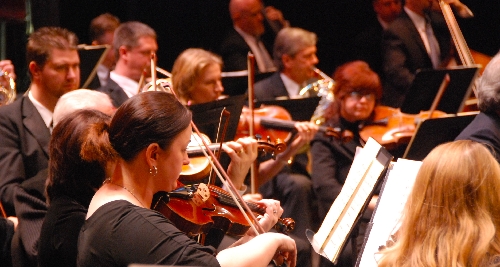Las Vegas Philharmonic going Gershwin

Long before the term "crossover artist" existed, George Gershwin blazed the trail.
After creating imperishable popular tunes from Tin Pan Alley to Broadway to Hollywood (along with his ace lyricist, brother Ira), the composer conquered the concert hall with such orchestral classics as "Rhapsody in Blue" and "American in Paris."
The latter two works are just part of Saturday’s Las Vegas Philharmonic all-Gershwin concert at The Smith Center for the Performing Arts.
To cite one of the Gershwins’ most felicitous song titles, the sold out concert provides a " ‘S Wonderful" tour of the composer’s multifaceted musical legacy — including " ‘S Wonderful" itself, from the 1927 musical "Funny Face."
Soprano Lisa Vroman will join the Las Vegas Philharmonic and Music Director David Itkin for that tune and other Gershwin standards from "Someone to Watch Over Me" (from 1926’s "Oh, Kay!") to "Summertime" (from Gershwin’s folk opera "Porgy and Bess," featuring lyrics by DuBose Heyward).
Vroman also will perform "Isn’t It a Pity?" (from the 1933 musical "Pardon My English") and "They All Laughed" (from the 1937 Fred Astaire-Ginger Rogers movie "Shall We Dance") with pianist David Loeb , director of jazz studies at the University of Nevada, Las Vegas.
In addition to accompanying Vroman, Loeb will perform Gershwin’s 1924 "Rhapsody in Blue" with the Philharmonic.
Three orchestra-only works round out the program: the overture for the 1931 political satire "Of Thee I Sing" (an appropriate choice this election year, Itkin notes), plus part of the "Catfish Row Suite" featuring melodies from "Porgy and Bess" and, as a finale, 1928’s "An American in Paris."
Taken as a whole, "it’s as American as it gets," says Loeb of Gershwin’s melting-pot music, which combines popular, jazz, folk, blues and classical influences. "He’s certainly one of the main artists who brought" the "earthiness" of those disparate styles to the concert hall.
Vroman’s presence on the program also seems appropriate, considering the fact that she describes herself as a "crossover singer," with classical training, numerous classical performances, and Broadway roles that include "The Phantom of the Opera’s" Christine.
Saturday’s concert represents a dual reunion for Vroman .
Not only has she worked with Loeb at the Hollywood Bowl, where he was principal keyboardist for the resident orchestra, but she performed a previous Gershwin program with Itkin and the Abilene (Texas) Philharmonic, the other orchestra he regularly conducts.
"That was kind of a warm-up," Vroman says of that collaboration. "It was mostly an older crowd and they just loved it." After all, she points out, "it’s their music. But the younger ones were getting into it too."
Little wonder, considering the Gershwins’ output combines Ira’s "perfect" lyrics with the "sheer beauty" of George’s melodies, Vroman says.
"You don’t get that from pop music today," she adds.
"There’s definitely something about Gershwin’s music," agrees Itkin, citing "the incredible combination of music and lyrics," along with "a very unique style and power."
In addition to creating "melodies (that) are second to nobody else’s, there’s a real melding, particularly in the orchestral pieces," Itkin observes. "It’s more than good popular songs translated for orchestra."
Indeed, the soaring, syncopated sounds of "Rhapsody in Blue" — which have accompanied everything from Woody Allen’s 1979 comedy "Manhattan" to United Airlines TV commercials — remain "as new and fresh" as ever, Loeb maintains. "It’s really a culmination of Gershwin’s genius."
Gershwin himself described the composition as "a sort of musical kaleidoscope of America, of our vast melting pot, of our unduplicated national pep, of our metropolitan madness." He composed it in 1924 after bandleader Paul Whiteman requested a concertolike piece for a New York concert billed as "An Experiment in Modern Music."
At Saturday’s Las Vegas concert, Loeb hopes to "capture the spirit of American jazz and the marriage of that with classical" music while performing "Rhapsody in Blue," he says.
As part of his performance, Loeb plans to "incorporate the improvisational aspect" of the piece, playing "the cadenzas (Gershwin) originally played" at "Rhapsody’s" 1924 debut — which the composer improvised onstage, writing them down following the concert.
Some 13 years after that landmark performance, Gershwin died at 38, following surgery to remove a brain tumor.
And while it may be poignant to ponder what might have been had Gershwin lived, the composer lives on through his invigorating, idiosyncratic — and endlessly intriguing — music.
"It’s just extraordinary, the output he left us," Loeb says. "It’s miraculous — and marvelous." Or, to put it in true Gershwin terms, " ‘S Marvelous."
Contact reporter Carol Cling at ccling@reviewjournal.com or 702-383-0272.